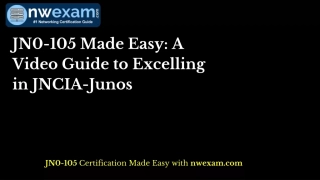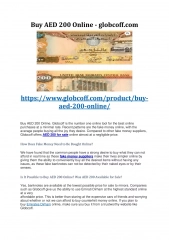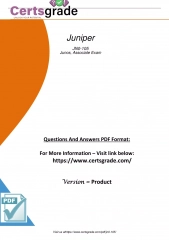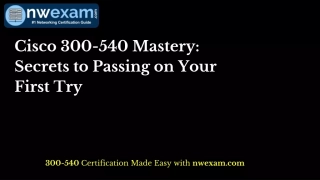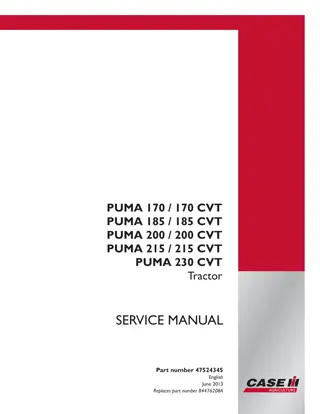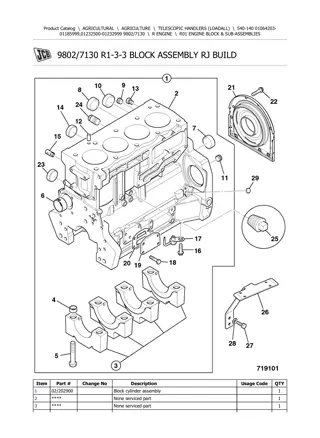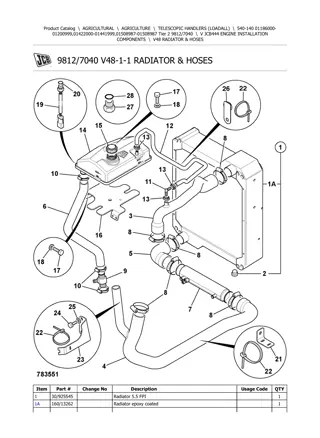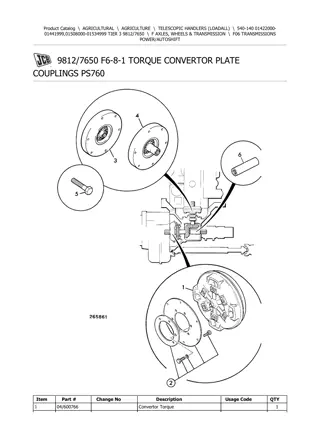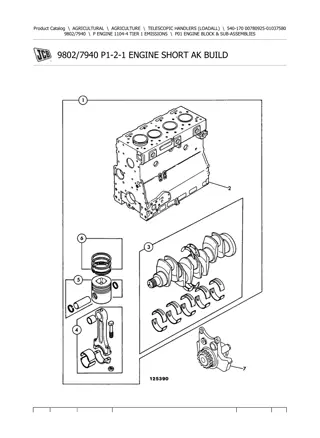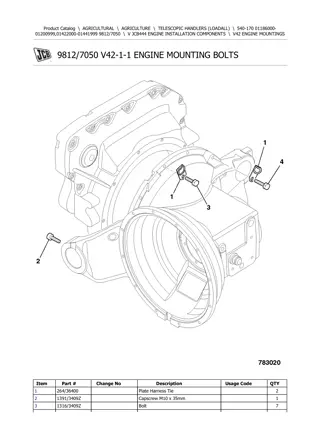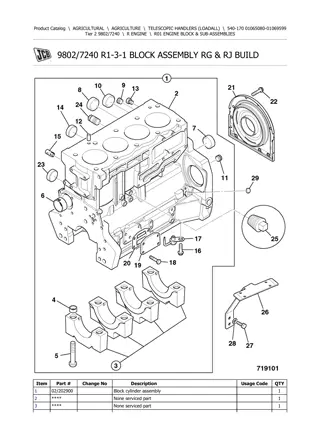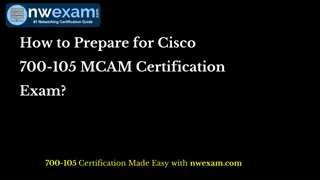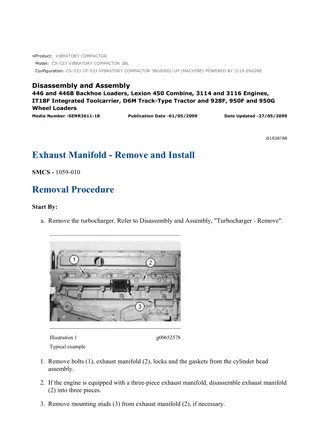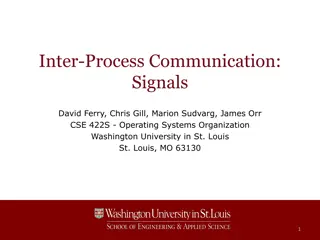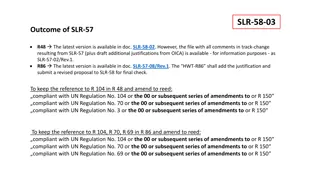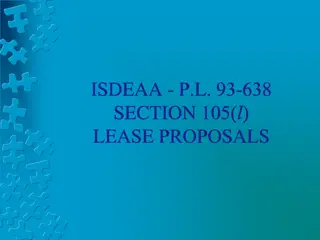
JCB 533-105, 535-v125, 535-v140, 540-140, 540-170, 540-200, 540-v140,540-v180, 550-140, 550-170 Telescopic Handler Service Repair Manual Instant Download
Please open the website below to get the complete manualnn//
Download Presentation

Please find below an Image/Link to download the presentation.
The content on the website is provided AS IS for your information and personal use only. It may not be sold, licensed, or shared on other websites without obtaining consent from the author. Download presentation by click this link. If you encounter any issues during the download, it is possible that the publisher has removed the file from their server.
E N D
Presentation Transcript
Foreword The Operator's Manual You and others can be killed or seriously injured if you operate or maintain the machine without first studying the Operator's Manual. You must understand and follow the instructions in the Operator's Manual. If you do not understand anything, ask your employer or JCB dealer to explain it. SERVICE MANUAL Do not operate the machine without an Operator's Manual, or if there is anything on the machine you do not understand. Treat the Operator's Manual as part of the machine. Keep it clean and in good condition. Replace the Operator's Manual immediately if it is lost, damaged or becomes unreadable. LOADALL (ROUGH TERRAIN VARIABLE REACH TRUCK) 533-105, 535-v125, 535-v140, 540-140, 540-170, 540-200, 540-v140, 540-v180, 550-140, 550-170 Contents 01 - Machine 03 - Attachments, Couplings and Load Handling 06 - Body and Framework 09 - Operator Station 12 - Heating, Ventilating Conditioning (HVAC) 15 - Engine 18 - Fuel and Exhaust System 21 - Cooling System 24 - Brake System 25 - Steering System 27 - Driveline 30 - Hydraulic System 33 - Electrical System 72 - Fasteners and Fixings 75 - Consumable Products 78 - After Sales EN - 9813/8750 - ISSUE 1 - 07/2017 and Air- This manual contains original instructions, verified by the manufacturer (or their authorized representative). Copyright 2017 JCB SERVICE All rights reserved. No part of this publication may be reproduced, stored in a retrieval system, or transmitted in any form or by any other means, electronic, mechanical, photocopying or otherwise, without prior permission from JCB SERVICE. www.jcb.com
15 - Engine 18 - Engine Belt 00 - General 00 - General Introduction Introduction .................................................. 15-111 Health and Safety ........................................ 15-112 Component Identification ............................. 15-112 A crankshaft pulley is used to drive a FEAD (Front End Accessory Drive) belt. The belt drives the coolant pump. Depending on the machine application, the belt is configured to drive engine mounted accessories, such as the alternator, cooling fan and air conditioning compressor. Some applications have a second pulley on the crankshaft which drives a dedicated fan belt. The belt drives an engine mounted cooling fan. 15 - 111 9813/8750-1 15 - 111
15 - Engine 18 - Engine Belt 00 - General Health and Safety Component Identification Turning the Engine Do not try to turn the engine by pulling the fan or fan belt. This could cause injury or premature component failure. WARNING! The engine has exposed rotating parts. Switch off the engine before working in the engine compartment. Do not use the machine with the engine cover open. Notice: A drive belt that is loose can cause damage to itself and/or other engine parts. Figure 303. A - With air condition- ing compressor, no cooling fan A 4 4 5 3 7 2 1 15 - 112 9813/8750-1 15 - 112
https://www.ebooklibonline.com Hello dear friend! Thank you very much for reading. Enter the link into your browser. The full manual is available for immediate download. https://www.ebooklibonline.com
15 - Engine 18 - Engine Belt 00 - General Figure 304. B - Without air condi- tioning compressor, no cooling fan Figure 305. C - With air conditioning com- pressor, cooling fan pulley installed B 4 C 6 4 5 5 3 4 3 7 2 2 1 1 1 Crankshaft drive pulley 2 Coolant pump drive pulley 3 Alternator drive pulley 4 Idler pulley 5 Tensioner pulley 7 Air conditioning compressor drive pulley 15 - 113 9813/8750-1 15 - 113
15 - Engine 18 - Engine Belt 00 - General Figure 306. D - Without air conditioning compressor, cooling fan pulley installed D 6 5 3 4 2 1 1 Crankshaft drive pulley 2 Coolant pump drive pulley 3 Alternator drive pulley 4 Idler pulley 5 Tensioner pulley 6 Cooling fan drive pulley 7 Air conditioning compressor drive pulley Note: Idler pulley positions differ slightly depending on the size of the fan pulley installed. Note: Different fan pulley size options are available. This enables a choice of fan/engine speed ratios. 15 - 114 9813/8750-1 15 - 114
15 - Engine 18 - Engine Belt 03 - Drive Belt 03 - Drive Belt Introduction Introduction .................................................. 15-115 Health and Safety ........................................ 15-116 Check (Condition) ........................................ 15-116 Adjust .......................................................... 15-117 Remove and Install ..................................... 15-117 The crankshaft pulley is used to drive the coolant pump via a FEAD (Front End Accessory Drive) belt. In addition to the coolant pump the drive belt can also be configured to drive the engine mounted accessories. The belt is maintained at a constant tension by a spring loaded tensioner. To achieve the necessary belt/pulley contact area the belt is routed around idler wheels as required. The configuration varies depending on the accessories installed. 15 - 115 9813/8750-1 15 - 115
15 - Engine 18 - Engine Belt 03 - Drive Belt Health and Safety Check (Condition) Notice: A drive belt that is loose can cause damage to itself and/or other engine parts. At the recommended service interval, visually inspect the drive belt for damage. 1. Make the machine safe. Refer to: PIL 01-03. 2. Stop the engine and let it cool down. 3. Renew the drive belt if it has cracks or if it is frayed or has pieces of material missing. Figure 307. B A C A Crack in belt B Missing piece of belt C Frayed belt 15 - 116 9813/8750-1 15 - 116
15 - Engine 18 - Engine Belt 03 - Drive Belt Adjust Remove and Install Adjustment is not possible with this drive belt. A spring loaded tensioning unit ensures that the FEAD (Front End Accessory Drive) belt is kept at the correct tension. Remove 1. Make the machine safe. Refer to (PIL 01-03). 2. Stop the engine and let it cool down. 3. Use a socket of the specified size to locate on to the hexagon spigot nut, carefully rotate the tensioner against the spring force in the direction shown. Do not use excessive force or the tensioner will be damaged. Dimension: 16mm 4. Keep holding the tensioner against the spring force and lift the belt off the drive tensioner pulley. 5. Slowly release the spring force by rotating the tensioner unit in the opposite direction. 15 - 117 9813/8750-1 15 - 117
15 - Engine 18 - Engine Belt 03 - Drive Belt Figure 308. C B A D A Spring loaded tensioner B Drive belt C Example of frayed drive belt (refer to Check Condition) D Spigot nut Install 1. The installation procedure is the opposite of the removal procedure. Additionally do the following step. 2. Before you install the new belt, check that the tensioner roller and the fan pulley rotate smoothly and that there is no play in the bearings. 15 - 118 9813/8750-1 15 - 118
15 - Engine 18 - Engine Belt 21 - Tensioner 21 - Tensioner Install 1. The installation procedure is the opposite of the removal procedure. Additionally do the following steps. Remove and Install Before Removal 2. Tighten the bolts to the correct torque value. 3. Install the drive belt, refer to (PIL 15-18). 1. Make the machine safe. Refer to (PIL 01-03). 4. Make sure that the drive belt is under tension and the locking pin is removed before starting the engine. Refer to Drive Belt - Adjust (PIL 15-18). 2. Make sure that the engine is safe to work on. If the engine has been running, let it cool before you start the service work. 3. Get access to the engine. Table 132. Torque Values Item 2 Nm 24 4. Remove the drive belt, refer to (PIL 15-18). Figure 309. 3 2 1 2 2 X T3 1 Drive belt tensioner pulley 2 Fixing bolts (x3) 3 Drive belt T3 Locking pin X Spigot nut Remove The drive belt tensioner is a non-serviceable item. If the drive belt tensioner or the idler wheel is faulty or damaged it must be renewed as a complete assembly. 1. To remove the tensioner assembly, remove the bolts and lift the tensioner pulley from the cylinder block. 15 - 119 9813/8750-1 15 - 119
15 - Engine 30 - Valve 00 - General 00 - General Introduction Introduction .................................................. 15-137 Technical Data ............................................. 15-138 Component Identification ............................. 15-139 Operation ..................................................... 15-141 Adjust .......................................................... 15-141 Remove and Install ..................................... 15-144 The valve train system opens and closes the valves with correct timing in relation to the piston movements. Each push rod has one end in a valve tappet and the other end under a rocker arm, or as applicable. The adjusting screw has a ball shaped end that locates in the push rod. The adjusting screw is used for setting the valve clearance. The valves extend through the cylinder head. There are no sleeves or valve guides in the cylinder head. The valves are made from a special metal to provide a long service life. Damaged or worn valves cannot be lapped or reground and must be replaced with new ones. Each valve stem has an oil seal. The Valve seat inserts are pressed into the cylinder head. The seat inserts are also made from a special metal to provide for a long service life. Damaged or worn seat inserts can be removed and replaced with new ones. 15 - 137 9813/8750-1 15 - 137
15 - Engine 30 - Valve 00 - General Technical Data Inlet opens (top of ramp) - SA, SB, SC - SD, SF Inlet closes - SA, SB, SC - SD, SF Exhaust opens - SA - SB, SC - SD, SF Exhaust closes - SA, SB, SC - SD, SF Valve stem diameter - SA, SB, SC 10 BTDC 6 BTDC For: JCB Tier 2/3 Elec Engine 4 Cyl ................................................. Page 15-138 For: JCB Tier 2/3 Mech Engine 4 Cyl ................................................. Page 15-138 32 ABDC 28 ABDC (For: JCB Tier 2/3 Elec Engine 4 Cyl) 50 BBDC 60 BBDC 41 BBDC Table 133. Inlet and Exhaust Valve Data Max lift Inlet Max lift Exhaust Inlet opens (top of ramp) 6 BTDC Inlet closes Exhaust opens Exhaust closes Valve stem diameter - Inlet - Exhaust Valve spring free length Valve guide bore diame- ter - min - max Valve face angle - Inlet - Exhaust Valve length Valve sealing 9.64mm @ 101 ATDC 9.84mm @ 115 BTDC 10 ATDC 9 ATDC 28 ATDC 41 BTDC 6 ATDC Inlet: 6.935 0.0075mm Exhaust: 6.975 0.0075mm Inlet: 6.928 6.943mm Exhaust: 6.975 6.933mm 40.18mm 6.928 6.943mm 6.918 6.933mm 51.1mm - SD, SF Valve spring free length Valve guide bore diameter - min - max Valve face angle - Inlet - Exhaust Valve length Valve sealing 6.958mm 6.973mm 6.958mm 6.968mm 60.5 45.17 131.9 132.4mm Stem seal with sealing washer 60.5 45.17 131.9 132.4mm Stem seal with sealing washer Valve head depth (below cylinder head surface) - Inlet - Exhaust Valve rim thickness Valve Clearances (en- gine cold) - Inlet - Exhaust Valve head depth (below cylinder head surface) - Inlet - Exhaust Valve rim thickness Valve Clearances (measured cold) - Inlet - Exhaust 0.89 1.39mm 0.95 1.45mm 2.98 3.38mm 0.89 1.39mm 0.95 1.45mm 2.98 3.38mm 0.19 0.27mm 0.56 0.64mm (1) 0.15 0.21mm 0.43 0.49mm (1) (1) The values refer to the tappet adjuster end of the valve rockers. (For: JCB Tier 2/3 Mech Engine 4 Cyl) Table 134. Inlet and Exhaust Valve Data Max lift Inlet - SA, SB, SC - SD, SF Max lift exhaust -SA - SB, SC - SD, SF 9.37mm @ 101 ATDC 9.64mm @ 101 ATDC 9.42mm @ 110 BTDC 9.42mm @ 115 BTDC 9.84mm @ 115 BTDC 15 - 138 9813/8750-1 15 - 138
15 - Engine 30 - Valve 00 - General Component Identification Figure 318. 6c 6b 6a7 9 10 15 3 5 16 1 4 2 3a 745700 1 3 4 6a 6c 7 9 11 13 Camshaft drive gear Camshaft Tappets (x8) Rockers - inlet (x4) Adjusting screws (x8) Rocker shaft Bridge pieces (x8) Retainer (x16) Oil seal - valve stems (x16) 2 3a 5 6b 6d 8 10 12 14 Crankshaft gear Lobes Push rods (x8) Rockers - exhaust (x4) Swivel tip - rockers Wave washers (x8) Valve springs (x16) Collets (x32) Valve seat inserts (x16) 15 - 139 9813/8750-1 15 - 139
15 - Engine 30 - Valve 00 - General 15 17 Inlet valves (x8) Valve stem 16 Exhaust valves (x8) Cross Sectional View Figure 319. 17 6c 11 12 8 10 13 6b 6a 9 6d 745930 14 6a 6c 8 10 12 14 Rockers - inlet (x4) Adjusting screws (x8) Wave washers (x8) Valve springs (x16) Collets (x32) Valve seat inserts (x16) 6b 6d 9 11 13 17 Rockers - exhaust (x4) Swivel tip - rockers Bridge pieces (x8) Retainer (x16) Oil seal - valve stems (x16) Valve stem 15 - 140 9813/8750-1 15 - 140
15 - Engine 30 - Valve 00 - General Operation Adjust Special Tools Description Crankshaft Turning Tool (95.25mm PCD)- JCB 4 Cylinder Ecomax and Dieselmax Valve Clearance Service Kit The camshaft drive gear is driven by the crankshaft gear at half the speed of the crankshaft. Camshaft lobes, two for each cylinder, (operating exhaust and inlet valves) actuate the valve tappets. Part No. 892/01147 Qty. 1 When the camshaft rotates the cam lobes act on the tappets. The push rods act on the rockers which pivot on the camshaft, depressing two valves at the same time via the bridge piece. 892/01380 1 Engine Position The screw is self locking in the rocker by means of a tapered thread. Wave washers act like springs to keep the rockers in their correct positions along the camshaft and prevent them contacting one another. The rockers incorporate a swivel tip to ensure alignment with the bridge piece. This prevents excessive wear. The engine needs to be set to two different positions to measure and adjust all of the valves. The graphics show which valves are applicable at which engine position. 1. Make sure that the engine is safe to work on. If the engine has been running, let it cool before you start the service work. Each valve has a compression spring. The function of the spring is to close the valve and at the same time return the rocker arm and push rod to ensure that the tappets follow the camshaft lobes. The spring is located on the valve stem by a retainer and split collets. 2. Get access to the engine. 3. Remove the tappet covers. Refer to (PIL 15-42). 4. Put the indicator pins into the holes inside the tappet adjusters for cylinder number 4. Make sure that the pins do not fall into the engine. 5. Use the crankshaft turning tool to turn the engine crankshaft clockwise. Stop turning the crankshaft when one indicator pin starts to move up after the other pin has moved down. This is the position where the exhaust valve is almost closed and the inlet valve is just starting to open. Special Tool: Crankshaft Turning Tool (95.25mm PCD)- JCB 4 Cylinder Ecomax and Dieselmax (Qty.: 1) Special Tool: Valve Clearance Service Kit (Qty.: 1) 6. Put a mark on the crankshaft pulley at the 12 o'clock position. 15 - 141 9813/8750-1 15 - 141
15 - Engine 30 - Valve 00 - General Figure 320. Figure 322. 360 Degree Position A 360 T7 2B 4B 1A 2A 1A Exhaust valve-Cylinder 1 2A Exhaust valve-Cylinder 2 2B Inlet valve-Cylinder 2 4B Inlet valve-Cylinder 4 T8 T8 Valve Clearances The procedure describes how to measure and, if necessary, adjust one valve clearance. The procedure for all the valves is the same. Do the procedure for the correct valves at each of the two engine positions. Remember you must remove the valve clearance service tools before you turn the engine crankshaft. A T7 Crankshaft turning tool T8 Indicator pins (obtain locally) 12 o'clock position 7. Turn the engine crankshaft 90 degrees clockwise. Important: The engine must be cold before you measure or adjust the valve clearances. 8. Measure and, if necessary, adjust the clearances for the correct valves. 1. Install the adaptor plate in the correct position on the rocker cover using the screws A. Figure 321. 90 Degree Position 2. Make sure that the crankshaft is in the correct position. 3. Put the adaptor sleeve on the correct valve tappet adjuster screw. 90 4. Push the lock bar into the correct valve tappet adjuster screw. 1B 3B 5. Tighten the lock bar by turning it with your hand. 3A 4A 6. Assemble the DTI support and DTI. 1B Inlet valve-Cylinder 1 3A Exhaust valve-Cylinder 3 3B Inlet valve-Cylinder 3 4A Exhaust valve-Cylinder 4 7. Push and then pull the lock bar in the direction of the arrows X and Y. Do this until you are sure that the lock bar is correctly installed and oil is moved away from the cam follower and push rod. 9. Remove the valve clearance service tools. Turn the engine crankshaft 360 degrees clockwise. Use the mark on the crankshaft pulley as a reference. 8. Important: Apply a side force on the lock bar at the same time as pushing and pulling. This prevents the rocker moving along the rocker shaft and giving a false reading on the DTI. Apply a force to the left on the exhaust valve tappets and to the right on the inlet valve tappets. 10. Measure and, if necessary, adjust the clearances for the correct valves. 15 - 142 9813/8750-1 15 - 142
15 - Engine 30 - Valve 00 - General Figure 323. Figure 324. T1 C T5 X A B T4 Y A T3 T2 T6 A T1 Dial Test Indicator (DTI)(obtain locally) T2 Adaptor plate (part of valve clearance service kit) T3 Adaptor sleeve (part of valve clearance service kit) T4 Lock bar (part of valve clearance service kit) T5 DTI Support (obtain locally) Screws B C T6 Spanner open ended (obtain locally) Tappet adjusters Rockers 9. Pull the lock bar in the direction of arrow Y and turn the DTI to zero. 10. Push the lock bar in the direction of arrow X and record the DTI indication. 11. Compare the valve clearance measurement with the correct clearances. If an adjustment is necessary: 11.1. Turn the tappet adjuster using an open ended spanner on the adaptor sleeve. Turn the sleeve clockwise to reduce the clearance and counterclockwise to increase the clearance. 11.2. Important: The tappet adjusters are set in position by thread friction with the rockers. Make sure that the torque to turn the tappet adjusters is more than the minimum necessary. If any of the adjusters show a lower torque value then the adjuster and its related rocker must be replaced. 15 - 143 9813/8750-1 15 - 143
15 - Engine 30 - Valve 00 - General Remove and Install Figure 325. Valve Stand Special Tools Description Valve Stem Seal Installation Tool (444/448/672 Engine) Part No. 892/01152 Qty. 1 EXHAUST EXHAUST EXHAUST INLET INLET INLET Before Removal 1. This procedure requires service parts. Make sure you have obtained the correct service parts before you start, refer to Parts Catalogue. CYL. 1 CYL. 2 CYL. 3 2. Make sure that the engine is safe to work on. If the engine has been running, let it cool before you start the service work. Remove 1. Use a spring compressor tool to compress each valve spring and remove the collets. Make sure that the springs are compressed squarely. 3. Get access to the engine. 4. Remove the thermostat, refer to (PIL 21-12). Figure 326. 5. Remove all of the fuel injector pipes, refer to (PIL 18-96). B 6. Remove the rocker cover, refer to (PIL 15-42). 7. Remove the fuel injectors, refer to (PIL 18-18). 8. Remove the rocker assembly, refer to (PIL 15-42). A 9. Remove the exhaust manifold, refer to (PIL 18-24). 10. Remove the inlet manifold, refer to (PIL 18-24). 11. Remove the cylinder head assembly from the cylinder block, refer to (PIL 15-06). A Spring compressor tool B Collets 12. Measure the valve recession with a suitable DTI (Dial Test Indicator). Clean the carbon deposits from a small area of the valve heads for location of the DTI probe. If the valve recession is outside the serviceable limits, it is advisable to obtain a new or reconditioned cylinder head assembly, refer to Technical Data (PIL 15-06). 2. Remove the spring compressor tool and lift off the retainer and valve spring. Figure 327. C 13. To aid removal and replacement, use a wooden valve stand to retain the valves after removal. Add labels to make sure that the valves are correctly replaced. D C Retainer D Valve spring 3. Turn the cylinder head on its side and withdraw the inlet valves and exhaust valves as shown. 15 - 144 9813/8750-1 15 - 144
15 - Engine 30 - Valve 00 - General Figure 328. If there is evidence of wear or damage to the valves, guides or seats, it is advisable to obtain a new or reconditioned cylinder head assembly. G Before Installation 1. Position the cylinder head upside down in a suitable jig or fixture. E F 2. Make sure that all items are clean and free from damage and corrosion. 3. Install the injectors into the cylinder head to do a trial check of the nozzle protrusion. Note the relative positions for the injectors, and then remove the injectors for installation at a later stage. E Cylinder head F Inlet valves G Exhaust valves Installation 1. The installation procedure is the opposite of the removal procedure. Additionally do the following steps. 4. When removing, note the respective position of each valve. Use a suitable valve stand to keep the valves together and identify them with their respective cylinder. Note: The exhaust valves have smaller diameter heads. 2. Install the new valve stem seals as shown. Use the installation tool to avoid damaging the seals. Pre-assemble the seal into the tool. Locate the tool over the valve guide and gently press the seal into place. Lubricate the seal with P80 fluid. Special Tool: Valve Stem Seal Installation Tool (444/448/672 Engine) (Qty.: 1) 5. Remove the valve stem seals. Discard the seals. Figure 329. 3. With the cylinder head on its side, insert the inlet valves and exhaust valves as shown. Make sure that the valves are installed in the correct positions. Lubricate the valve stems with clean engine oil before assembly. Carefully push the end of the valve stem through the stem seals. J H 4. Install the valve springs on to the valve stems, together with a retainer. Use the spring compressor tool to compress each valve spring and insert the collets. Make sure that the collets are correctly seated in the valve stem grooves, before you remove the spring compressor tool. After Installation H Valve stem seals J Punch tool 1. Tap the valve stems in turn using a rubber mallet top fully seat the valves. Inspection 1. Carefully clean the carbon deposits from the valves, take care not to damage the valve seats. 2. Check that the valves and valve seats are not cracked, burnt or damaged. 3. Check the valve stems and valve guides for wear, refer to Technical Data (PIL 15-30). 15 - 145 9813/8750-1 15 - 145
15 - Engine 33 - Connecting Rod 06 - Big-End Bearing Check (Condition) Remove and Install Special Tools Description Torque Wrench (10-100Nm) 1. Check the bearing shell surfaces for signs of damage and excessive wear. Part No. 993/70111 Qty. 1 2. Measure the crank pin diameters to confirm they are within service limits, refer to Technical Data (PIL 15-33). Before Removal 3. Renew any parts that are worn or not within the specified tolerances. 1. This procedure requires service parts. Make sure you have obtained the correct service parts before you start. Refer to Parts Catalogue. 2. Make sure that the engine is safe to work on. If the engine has been running, let it cool before you start the service work. 3. Get access to the engine. 4. Disconnect and remove the fuel pipes from the injectors. Refer to (PIL 18-96). 5. Remove the rocker cover. Refer to (PIL 15-42). 6. Remove the fuel injectors. Refer to (PIL 18-18). 7. Drain the oil from the engine. Refer to (PIL 15-21). 8. Remove the oil sump. Refer to (PIL 15-45). 9. Position the engine upside down in a suitable jig or fixture, supported at the front of the crankcase. The connecting rod and the big-end bearing cap have been fracture split and must be kept together as a set. Care must be taken to avoid contamination and or damage to the fracture split surfaces. Remove 1. It is recommended that the big-end bearing caps are removed in pairs, cylinders 1 and 4 and cylinders 2 and 3. Rotate the crankshaft so that the big-end bearing caps on cylinders 2 and 3 are positioned as shown. 2. Remove the bolts and lift off the big-end bearing caps from the connecting rods. The bolts must not be re-used, discard the bolts. 15 - 154 9813/8750-1 15 - 154
15 - Engine 33 - Connecting Rod 06 - Big-End Bearing Figure 330. Figure 331. 5 4 Z 3 X 2 1 1 1 Big-end bearing caps 2 Big-end bearing cap bolts X Cast notch 6 2 2.1. Make sure that the tool is kept in inline with the bolt to avoid damaging the screw thread. 1 Big-end bearing cap 2 Bolts 3 Connecting rod 4 Piston 5 Piston rings 6 Big end bearing shells Z Fracture split surfaces 3. Lift out the bearing shells from the bearing caps. Carefully rotate the crank to disengage from the connecting rods and get access to the upper bearing shells. Lift out the upper bearing shells. It is recommended that the bearing shells are renewed. If they are to be reused, label the bearing shells to make sure that they are installed in their original positions on assembly. 4. Carefully rotate the crankshaft to position the big- end bearing caps of cylinders 1 and 4. Make sure that the crank does not foul the connecting rods of cylinders 2 and 3. Remove the bearing caps and bearing shells as described in previous steps. 5. Inspect the big-end bearings for signs of damage and excessive wear. Refer to Check Condition (PIL 15-12). Install 1. The installation procedure is the opposite of the removal procedure. Additionally do the following steps. 2. Make sure that all items are clean and free from damage and corrosion. 3. Install the upper bearing shell to the connecting rod. Lubricate the bearing shell with clean engine oil. 15 - 155 9813/8750-1 15 - 155
Suggest: If the above button click is invalid. Please download this document first, and then click the above link to download the complete manual. Thank you so much for reading
15 - Engine 33 - Connecting Rod 06 - Big-End Bearing 4. Install the lower bearing shell to the big-end bearing cap. Lubricate the bearing shell with clean engine oil. Install the big-end bearing cap to the connecting rod. Make sure that the cast notch on the bearing cap faces to the front of the engine. Use compressed air to clean the fracture surfaces before assembly. 5. Install new fixing bolts. Tighten the new bolts in three stages to the correct torque value. Special Tool: Torque Wrench (10-100Nm) (Qty.: 1) Figure 332. T3 T3 Angle gauge (obtain locally) 5.1. Make sure that the tool is kept in inline with the bolt to avoid damaging the screw thread. 6. The bolts are tightened using a torque and angle method. Refer to Fasteners and Fixings, General, Introduction (PIL 72-00). Figure 333. Y +90 0 After Installation 1. Carry out the procedures listed in Before Removal in reverse order. Table 136. Item 2 - 1st Stage 2 - 2nd Stage 2 - Final Stage Torque Value 35N m 65N m 90 15 - 156 9813/8750-1 15 - 156
https://www.ebooklibonline.com Hello dear friend! Thank you very much for reading. Enter the link into your browser. The full manual is available for immediate download. https://www.ebooklibonline.com


